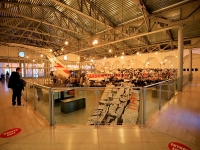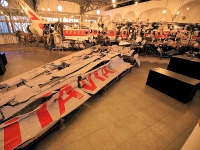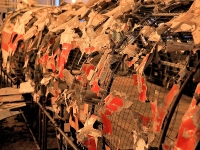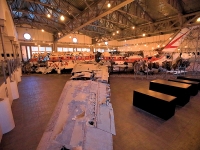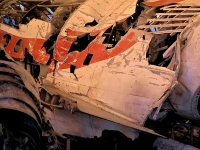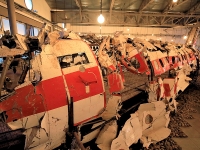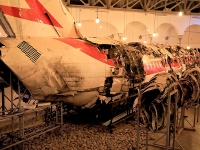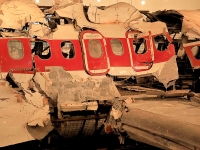Kultur
Museum for the Memory of Ustica is a museum in Bologna
the Modern Art Gallery of Bologna
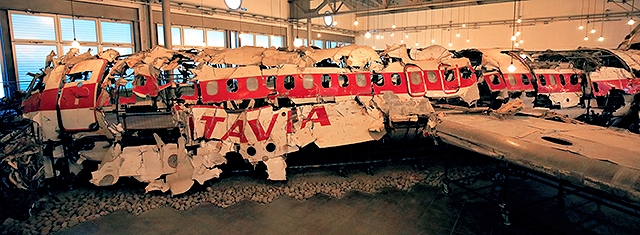
Museum for the Memory of Ustica Bologna Italy (Quelle: Roberto Magni by Foto ReD Photographic Agency)
GDN -
The Museum for the Memory of Ustica is a museum in Bologna in commemoration of the Ustica massacre and its victims.
It is part of the Modern Art Gallery of Bologna.
It is based in the buildings of the former Zucca tram depot, in the Bolognina district of Bologna.
It is part of the Modern Art Gallery of Bologna.
It is based in the buildings of the former Zucca tram depot, in the Bolognina district of Bologna.
The museum, created thanks to the determination of the Association of Relatives of the Victims of the Ustica Massacre, was inaugurated on 27 June 2007, on the occasion of the 27th anniversary of the massacre, in the presence of the Mayor of Bologna Sergio Cofferati, the Minister of Sport and youth policies Giovanna Melandri and Daria Bonfietti, president of the Association.
The museum houses the remains of the DC-9 reconstructed within the large spaces of the former ATC Warehouse. An installation by Christian Boltanski was set up around the wreck, consisting of 81 lights and 81 mirrors in memory of the 81 victims of the massacre. Some crates contain, hidden from the view of visitors, the personal items belonging to the victims. A collection of photographs of these objects is available, made available to the museum public in the publication, commissioned by Boltanski himself, List of personal objects belonging to passengers on flight IH 870.
The Ustica massacre was a plane crash, which occurred at 20:59 (UTC + 2) on June 27, 1980 over the strait between the Italian islands of Ponza and Ustica.
Scheduled flight IH870 was involved, which departed from Bologna-Borgo Panigale airport and headed to Palermo-Punta Raisi airport, operated by the Douglas DC-9 aircraft of the Itavia airline. The latter lost radio contact with the Rome-Ciampino airport, responsible for air traffic control in that sector, disintegrated and fell into the Tyrrhenian Sea. All 81 occupants of the aircraft died in the massacre, including passengers and crew. It is the fourth Italian air disaster for the number of victims, after those of Alitalia flight 4128, Alitalia flight 112 and Linate.
Several decades later, various aspects of the accident are still not fully clarified, starting from the dynamics itself.
Various hypotheses have been formulated over the years regarding the nature, dynamics and causes of the accident: one of the most jokes, and therefore accepted with validity in criminal and compensation matters, concerns an international involvement, in particular French, Libyan and US , with the DC-9 that would have found itself in the line of fire of an air combat, finally being targeted by mistake by a missile (specifically fired by a NATO fighter against a MiG of the North African state aviation). Other hypotheses, however less accredited and, to the test of the facts, proved to be inconsistent, speak of structural failure or a terrorist attack (an explosive device in the toilet of the aircraft), a hypothesis however denied by the discovery of various intact parts of the fuselage, such as bogies and trunk, which suggested that there had been no internal explosion.
Francesco Cossiga, President of the Council of Ministers at the time of the plane crash, in 2007 attributed the responsibility to a French "resonance and non-impact" missile, destined for the Libyan aircraft on which, according to him, he would have found himself Gaddafi. A similar thesis is at the basis of the confirmation, by the Supreme Court, of the civil sentence for compensation to the families of the victims, imposed against the Ministries of Transport and Defense by the court of Palermo.
From a criminal point of view, also, the proceedings for high treason against four members of the Italian military leaders ended with the acquittal of the accused. Other proceedings against about 80 military personnel of the Air Force resulted in convictions for various crimes, including forgery and destruction of documents.
Aldo Davanzali's Itavia company, already heavily indebted before the accident, ceased operations on 10 December 1980; on 12 December, her license as an aircraft operator was revoked with jeopardizing employment levels and, within a year, the receivership procedure was opened, which was followed by the assignment of the aircraft fleet and personnel to Aermediterranea, a company owned by the then national airline Alitalia and its subsidiary ATI.
In 2018, the Supreme Court condemned the Ministries of Infrastructure and Defense to compensate the heirs of the owner of the Itavia company for the financial distress he faced after the Ustica plane crash; the two ministries were found guilty of failing to control the risk situation created in the skies of Ustica where unauthorized and unidentified military aircraft crossed the airway assigned to the Itavia flight.
weitere Informationen: https://www.redmagazine.red
Für den Artikel ist der Verfasser verantwortlich, dem auch das Urheberrecht obliegt. Redaktionelle Inhalte von GDN können auf anderen Webseiten zitiert werden, wenn das Zitat maximal 5% des Gesamt-Textes ausmacht, als solches gekennzeichnet ist und die Quelle benannt (verlinkt) wird.

